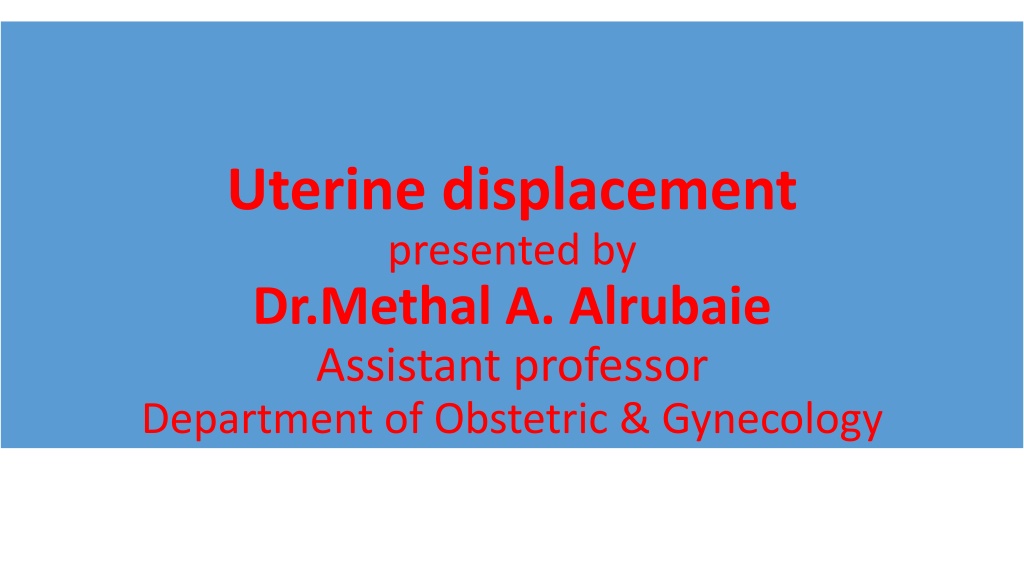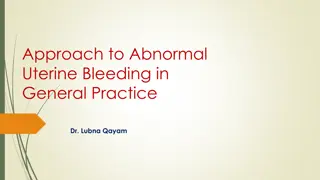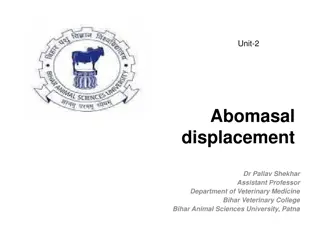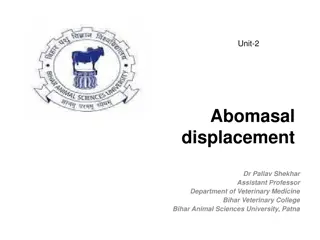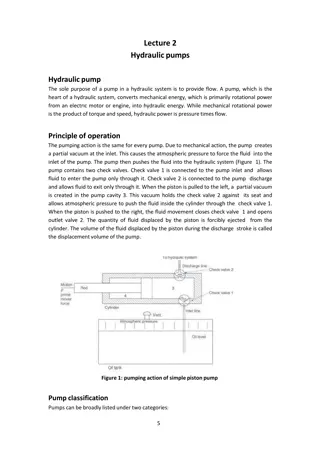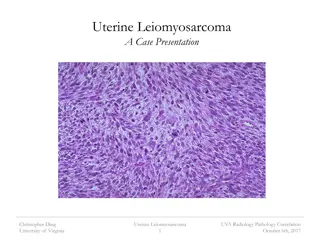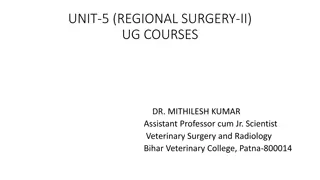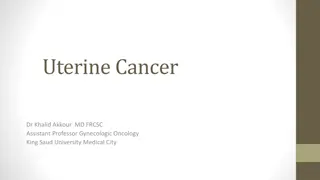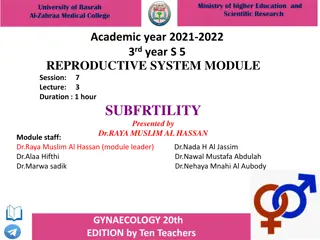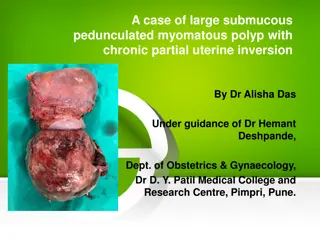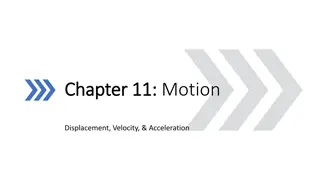Understanding Uterine Displacement: Causes, Symptoms, and Treatment
Uterine displacement refers to the abnormal positioning of the uterus, such as retroversion and retroflexion. This article discusses the classification, etiology, diagnosis, and treatment of uterine displacements, focusing on retroverted uterus during pregnancy. Factors affecting uterine position and clinical features of various types of displacement are also explored.
Download Presentation

Please find below an Image/Link to download the presentation.
The content on the website is provided AS IS for your information and personal use only. It may not be sold, licensed, or shared on other websites without obtaining consent from the author. Download presentation by click this link. If you encounter any issues during the download, it is possible that the publisher has removed the file from their server.
E N D
Presentation Transcript
Uterine displacement presented by Dr.Methal A. Alrubaie Assistant professor Department of Obstetric & Gynecology
Objectives Objectives *To define what is uterine displacement & how it is classified *To discuss in details backward displacement. * Explain the etiology behind backward displacement & what is the differential diagnosis. *Discuss the methods of diagnosis & treatment. * Identify the prognosis of retroverted uterus during pregnancy.
Position of uterus Position of uterus *Normal position of uterus is anteverted anteflexed (i.e. the body of uterus is directed forward & the cervix backward). * The supra-vaginal portion of cervix is relatively fixed point. * So uterine displacement mean rotation of body of uterus around this fixed point. * uterus has limited range of movements. * Factors affect the position of uterus are:- 1. Full bladder. 2. Raised intra-abdominal pressure as by cough, bear down. 3. Altered posture; the uterus lie lower in standing & lowest in squatting position.
Backward displacement Backward displacement Retroversion:- The long axis of cervix is directed upward backward in relation to long axis of the trunk. Retro flexion:- The long axis of the body of uterus is bend backward on the long axis of the cervix. Usually retroversion retro flexion occur together. Frequency:- It affect 15% of women. Etiology:- 1. congenital:- This type occur in nulliparous, there is mobile retroverted uterus with shallow anterior vaginal fornix ,the cervix is continuous with anterior vaginal wall & the vagina appear shorter than average.
2. Prolapse:- As the uterus is prolapsed it pull the vagina with it so it is slightly retroverted. 3. Endometriosis:- It caused fixed type of retroversion if it affect utero-sacral ligament & P.O.D. 4. Tumors & adhesions:- Tumor in front of uterus push uterus backward or adhesions behind the uterus pull it backward. 5. Puerperal:- After delivery the uterus involute while the controlling ligaments remain slacking & sub involute so the uterus directed backward , it last for (3-6 weeks) & then corrected to ante version ant flexion. If remain retroverted retroflexed it mean the original position of uterus is retroverted. It is usually mobile type. Clinical features: - A. Symptoms:- In mobile type it is symptomless & the only risk is the perforation of uterus if not diagnosed during D& C.
In fixed type there is:- * Spasmodic dysmenorrhea. * Lower backache & pelvic pain. * Deep dyspareunia:- due to direct pressure on uterus during coitus so it is position dependent & pain can be reduced by change the position during intercourse. *Pelvic congestion syndrome:- this in arise due to broad ligament torsion by retroversion so it cause inference with venous & lymphatic drainage & leave pelvic organs edematous & congested. It is presented with congestive dysmenorrhea, deep dyspareunia, menorrhagia, premenstrual pelvic pain & leucorrhea. * Infertility:- the cervix is directed a away from seminal pool & ejaculation directly into external os of cervix is less likely in addition that cervix is closed by anterior vagina. * Recurrent abortion.
B. Signs:- * By pelvic examination ;the cervix is directed upward & the external os is unusually visible easily. * The body of uterus is felt in P.O.D. * Tenderness is a striking feature during pelvic examination. Differential diagnosis:- * Tubal & ovarian tumor prolapsed into P.O.D. * Mass in large bowel. * Endometriosis in P.O.D. * Hematoma or abscess in P.O.D. * Uterine myoma in posterior wall of uterus. Prevention:- *Regular emptying of bladder to avoid over distension. * Early mobilization. * Pelvic floor exercise.
* Encourage the patient to lie with face downward for half one hour once or twice daily to induce ante version. The important time is (10- 28 days) after labor since before that the uterus is large so promontory of sacrum prevent correction this is applied for puerperal retroversion. Treatment:- 1. Mobile type:- No treatment is required since it is symptomless & just reassure the patient that it is normal. 2. Fixed type:- The treatment is directed primarily to the disease that cause retroversion. Methods of treatment are:- A. Manual replacement:- By move the cervix backward so the fundus will rotate forward & can caught by abdominal hand to keep it in its original position. B. Pessary use:- this type of treatment will correct retroversion temporarily & not cure the retroversion. Hodge pessary is the most efficient; it add pressure on posterior vaginal fornix & uterosacral ligament so pull the cervix backward. It is indicated in:- * As therapeutic test:- If there is doubt that symptoms are caused by
Retroversion or not so insert the pessary for one month & ask the patient to report whether the symptoms disappear or not, if disappear so advise to keep it for (2-3)months. * pregnancy:- If spontaneous correction not occur. C. Surgery:- it is indicated in the following:- 1. If the symptoms are caused by retroversion proved by pessary test. 2. In cases of deep dyspareunia. 3. As part of operation for endometriosis & myoma. 4.In cases of infertility & habitual abortion. Types:- 1. Baldy Webster operation:- By hold the loops of round ligaments through anterior & posterior leaves of broad ligament & sutured to the back of uterus. 2. Gilliams operation:- By hold the loops of round ligaments through internal abdominal ring & sutured to the back of rectus sheath using permanent suture.
3. Laparoscopic ventro-suspension. 4. Shortening of utero-sacral ligaments. Retroverted gravid uterus:- It affect 15% of pregnancies. The prognosis can be:- * Spontaneous correction:- It occur by tenth week of gestation in nearly almost pregnancies. * Sacculation of uterus:- If the fundus remain beneath the sacral promontory so the pregnancy continue by growing of anterior uterine wall producing a saccule or diverticulum, if this not recognized the body of uterus remain in pelvis act as tumor obstruct the delivery & safe treatment is C/S. * Impaction of uterus (incarcerated uterus):- The fundus of uterus fail to clear above the sacral promontory & the whole uterus remain in pelvis by (12-14weeks).
The uterus push the fundus of bladder forward & the base backward so acute retention of urine arise due to interference with internal urethral opening posteriorly. On examination there is soft abdominal mass which is full bladder & mistaken with uterus. By pelvic examination it is difficult to feel cervix because it is drawn high up in anterior vaginal wall. Differential diagnosis include:- 1. Other causes of acute retention of urine. 2. Other causes of tumor in P.O.D. as hematocele. Treatment:- * Slow drainage of bladder while the patient is kept prone in exaggerated Sims position. *If no spontaneous correction occur after drainage so insert large pessary. * if no response so surgical treatment is indicated.
